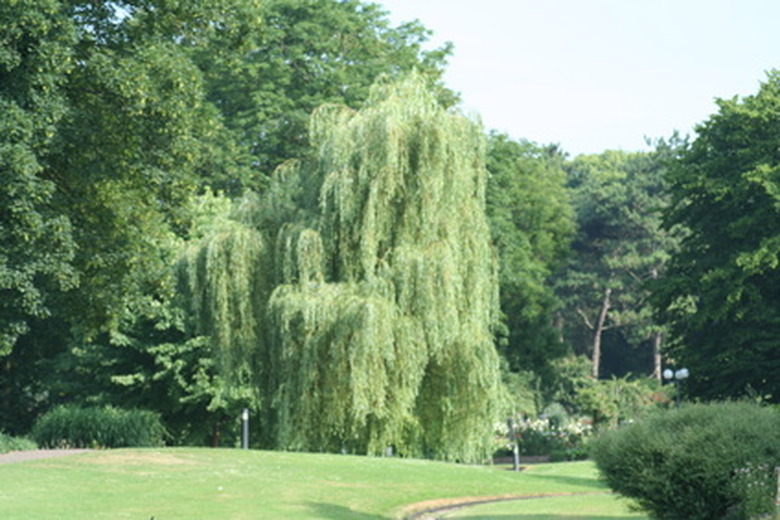Characteristics Of Weeping Willow Trees
A graceful, flowing weeping willow tree might seem like the perfect addition to the landscape. These towering trees grow quickly and produce instant shade with a thick canopy of arching branches. Willows thrive in moist soil, full sun and prefer locations near bodies of water for rapid absorption of water through this tree's roots. Weeping willows require continual care because of brittle wood, which causes broken branches.
Foliage
Landscapers prize weeping willows for the graceful, draped foliage of this ornamental tree. The weeping willow features narrow leaves shaped like a lance. Leaf length can be up to 8 inches, with leaves hanging vertically off the branch to create the flowing look associated with this plant. Willows produce a medium green leaf that transforms to yellow in the fall. Willows are deciduous trees that lose foliage each year but produce new foliage before most other trees in the spring. Foliage provides abundant shade, but limits the ability to grow anything under the tree canopy.
- A graceful, flowing weeping willow tree might seem like the perfect addition to the landscape.
- Leaf length can be up to 8 inches, with leaves hanging vertically off the branch to create the flowing look associated with this plant.
Flowers
Landscapers value weeping willows for their stunning foliage, but this tree also produces a fuzzy yellow flower that resembles a small caterpillar. Flowers are 1 inch in length and usually appear before leaves in the spring.
Bark
Weeping willow bark has been used medicinally for hundreds of years. Landscapers find willow bark extremely brittle because of its tendency to constantly shed twigs. Willows also suffer from brittleness at some of the largest section of the tree trunk. Bark is light brown in color and smooth in immature specimens. Trunk and limb bark develops a more traditional ridged texture with furrows as the plant matures. Regular pruning helps the weeping willow develop arching limbs, which creates the traditional umbrella-shaped canopy.
- Landscapers value weeping willows for their stunning foliage, but this tree also produces a fuzzy yellow flower that resembles a small caterpillar.
Growth
Willow trees might provide stunning additions to the landscape, but homeowners must carefully weigh the cons when planting this tree. Willow roots constantly seek out water and will penetrate underground water lines in this necessary quest for moisture. Roots grow close to the surface and can quickly displace sidewalks and pathways. Weeping willows grow relatively quickly and can reach heights of up to 70 feet. Some cultivars of the weeping willow gain up to 8 feet in height each year. Allowing enough space for the mature size of the tree as well as the spreading root system will help limit some of the maintenance required with this beautiful ornamental tree.
